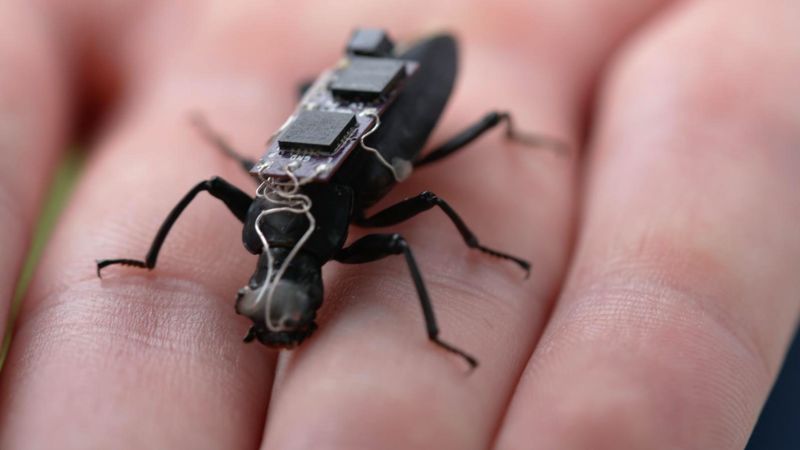In a groundbreaking research project at the University of Queensland, students and scientists are exploring the intersection of biology and technology through the development of biohybrid robots. One particularly intriguing experiment involves the use of live beetles as part of a system designed to create a part-living, part-machine entity. As part of the procedure, the beetle is submerged in an ice bath to serve as an anesthetic, allowing Lachlan Fitzgerald, a dedicated student in mathematics and engineering, to attach a tiny circuit board onto its back. This innovative approach aims to merge the biological capabilities of the beetle with technological enhancements that allow for remote control through electrical signals.
Fitzgerald’s creation utilizes a backpack-like device that can send electrical pulses to the beetle’s antennae. This enables him and his research team to manipulate its movements, tapping into the beetle’s natural agility and responsiveness. Fitzgerald emphasizes the importance of precision in controlling the creature. He notes that intervention only occurs when the beetle strays from the desired path, highlighting the delicate nature of the process. This meticulous technique lays the foundation for what Fitzgerald imagines as a future army of cyborg beetles trained for search and rescue operations, especially in scenarios following disasters like earthquakes or bomb attacks. In such events, traditional rescue methods might be hampered by risks, but cyborg beetles could navigate perilous environments, locating survivors and assessing dangers efficiently.
The biorobotics lab at the University of Queensland is not limited to beetles. It also explores the potential of giant burrowing cockroaches, which are native to Australia and can grow up to eight centimeters long. Alongside darkling beetles, these insects act as the subjects for control backpack testing. Fitzgerald shows no discomfort when handling these creatures, stating confidently that they do not gross him out. His perspective highlights a broader trend in research that favors the innate adaptability of insects over traditional robotic systems, which often struggle to cope with unforeseen challenges in dynamic environments.
The potential applications of cyborg insects bridge multiple domains, particularly in disaster response. Fitzgerald envisions these engineered insects playing a crucial role in locating and rescuing individuals trapped under rubble, as well as delivering essential medications to those in need. However, researchers still face the complex challenge of mastering the control of these insects’ movements, which may take time. Despite this, Fitzgerald’s optimism rings clear; he believes that what seems like an ambitious endeavor today could evolve into a life-saving reality over the coming decades.
Other institutions around the world are embarking on similar ventures. For instance, researchers at the California Institute of Technology are implanting electronic pacemakers into jellyfish to regulate their swimming capabilities, aiming to collect valuable data from the depths of the ocean. Meanwhile, Cornell University scientists have pioneered robots that utilize signals generated by mushroom organisms to navigate their surroundings, demonstrating a versatile approach to biohybrid technology.
Amidst the excitement surrounding biohybrid robots, ethical concerns have surfaced regarding the implications of manipulating living organisms. Researchers highlight the importance of oversight and regulatory measures to ensure humane treatment of these creatures during experiments. Academic teams at institutions like Caltech are actively engaging with bioethicists to mitigate any potential distress caused to the jellyfish involved in their studies.
Fitzgerald maintains that the beetles equipped with backpacks seem to exhibit normal life expectancies, suggesting that their quality of life is not significantly compromised by the modifications. He acknowledges the complexity of determining consciousness in these organisms and respects the valid concerns surrounding their welfare. Ultimately, however, he argues that the potential lifesaving capabilities of biohybrid robots warrant consideration and outweigh apprehensions about ethical implications. Through this groundbreaking research, Fitzgerald and his colleagues are at the frontier of a technology that could redefine the capabilities of robots, permanently altering the landscape of disaster response and emergency assistance.



